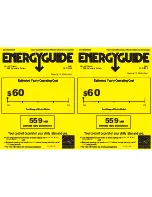
11
CARE AND MAINTENANCE
CLEANING YOUR APPLIANCE
•
Turn off the power, unplug the appliance, and remove all items, including shelves.
•
Wash the inside surfaces with a solution of warm water and baking soda (about 2 tablespoons of
baking soda to a quart of water).
•
Wash the shelves with a mild detergent solution.
•
Wring excess water out of the sponge or cloth when cleaning the area where the controls are located,
or any electrical parts.
•
Wash the outside cabinet with warm water and mild liquid detergent. Rinse well and wipe dry with a
clean soft cloth.
•
Use an approved stainless steel cleaner to clean the door and handle. Do not use steel wool or a
steel brush on the stainless steel.
CAUTION:
Failure to unplug the appliance during cleaning could result in electrical shock or other personal injury.
POWER FAILURE
Most power failures are corrected within a few hours and should not affect the temperature of your
appliance if you minimize the number of times the door is opened. If the power is going to be off for a
longer period of time, you need to take the proper steps to protect the contents.
VACATION TIME
•
Short vacations:
Leave the appliance operating during vacations of less than three weeks.
•
Long vacations:
If the appliance will not be used for several months, remove all items and turn off
the appliance. Clean and dry the interior thoroughly. To prevent odor and mold growth, leave the
door open slightly, blocking it open if necessary.
MOVING YOUR APPLIANCE
1. Remove all items.
2. Securely tape down all loose items (shelves) inside your appliance.
3. Turn the adjustable legs up to the base to avoid damage.
4. Tape the door shut.
5. Be sure the appliance stays secure in the upright position during transportation. Also, protect the
outside of the appliance with a blanket or similar item.
ENERGY SAVING TIPS
•
The appliance should be located in the coolest area of the room or outdoor location, away from heat-
producing appliances and out of direct sunlight.
•
Ensure that the unit is adequately ventilated. Never cover air vents.
•
Do not keep the door open any longer than necessary.
•
Let hot foods cool to room temperature before placing in the unit. Overloading the unit forces the
compressor to run longer.
•
Be sure to wrap foods properly, and wipe containers dry before placing them in the unit. This cuts
down on frost build-up inside the unit.
•
Unit shelves and storage bins should not be lined with aluminum foil, wax paper or paper toweling.
Liners interfere with cold air circulation, making the unit less efficient.
•
Organize and label stored items to reduce door openings and extended searches. Remove as many
items as needed at one time, and close the door as soon as possible.
Summary of Contents for FROST-FREE BUILT-IN FREEZER
Page 14: ...14 NOTES...
Page 15: ...15 NOTES...


































